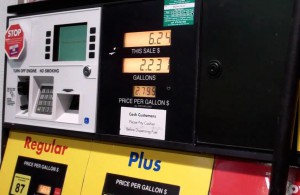The price of gasoline has now fallen for more than a month, according to a new report from AAA, as American motorists plunge ahead with the busiest summer for driving in nearly a decade.
At the beginning of the week, the average price of a gallon of gas has dropped for 30 consecutive days after a mini-surge in the spring, AAA said. It is the longest streak of falling prices since August/September of 2015. Moreover, gasoline prices are now at their lowest mark for mid-July since 2004.
The national average price for regular unleaded gasoline is $2.23 per gallon, which is four cents per gallon less than a week ago, fifteen cents less than a month ago and 53 cents less than one year ago.
Prices for some drivers are even lower with some 25,000 gas stations (approximately a quarter of stations) nationwide now selling gasoline for less than $2.
The Lundberg Survey released this week noted the average price of midgrade unleaded was $2.57 a gallon and $2.78 for premium. The U.S. average diesel price is $2.41 per gallon, down a penny from two weeks ago.
The highest average price for regular gasoline in the Lower 48 was $2.90 a gallon in the San Francisco Bay Area. The lowest was $1.91 in Charleston, South Carolina, according to Lundberg.
(California regulators reject VW plan to repair 3.0-liter diesels. For more, Click Here.)
AAA reported the West Coast remains the most expensive region to by gasoline in the country, led by California at $2.88 per gallon, Washington at $2.67 and Nevada at $2.57. The nation’s least expensive markets are South Carolina at $1.93 per gallon, Oklahoma and Mississippi at $2 and Missouri $2.01, AAA said.
Gasoline prices are poised to continue their slide this week as both crude oil and wholesale gasoline prices continues to drop. West Texas Intermediate and Brent crude were each down more than 7% last week, with WTI, the primary U.S. benchmark, falling from $48.99 to $45.41 or by 7.9% during the course of the holiday-shortened trading week as a rally in the price of crude oil fizzled out.
(Click Here for details about GM’s new legal setback.)
The price of oil currently reflects slightly more than half the price of gasoline at the pump, so lower oil prices are expected to result in lower retail gas prices for drivers. Additionally, the most recent Department of Energy report cited domestic gasoline production at just 100,000 barrels per day short of the all-time record, lending further momentum to falling prices.
Global oil prices have continued to sag thanks largely to indications of increased supply. This includes reports that June production by the Organization of Petroleum Exporting Countries rose to more than 32.5 million barrels per day, as Nigerian production ramped up following disruptions.
(To see more about the latest decline in gas prices, Click Here.)
While these reports have pressured global prices lower, the region remains volatile and an incident that impacts production or heightens geopolitical concerns could send prices higher again. At the close of Friday’s formal trading session on the NYMEX, WTI was up 27 cents to settle at $45.41 per barrel.


Gas prices should continue to fall. The price in Southwest Michigan went UP twenty-five to thirty cents yesterday, July 13, and in South Haven, MI, it went up forty-three cents. I only wish when the price goes up, someone, Gas Buddy included, would give us the reason, whatever it may be, supply/demand, refinery trouble, just because they can?
Apparently, no one has received that news, up here, in Washington State. Can you yell a little louder?
Up here, in the State of WA, apparently we haven’t gotten the news. Could you yell a little louder?